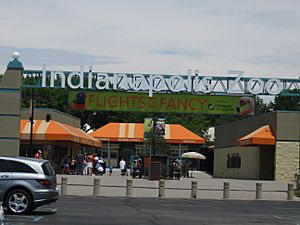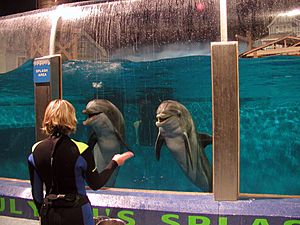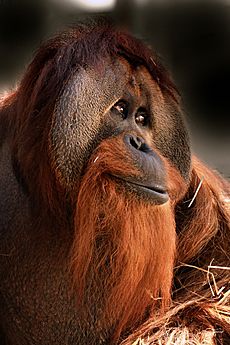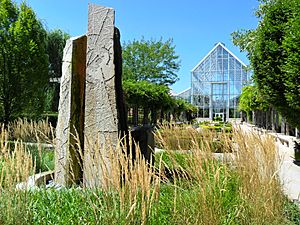Indianapolis Zoo facts for kids

Zoo entrance (2012)
|
|
| Date opened | April 18, 1964 |
|---|---|
| Location | Indianapolis, Indiana, U.S. |
| Land area | 64 acres (26 ha) |
| Coordinates | 39°46′1″N 86°10′37″W / 39.76694°N 86.17694°W |
| No. of animals | 3,800 |
| No. of species | 320 |
| Annual visitors | 1.1 million (2019) |
| Memberships | AZA, AAM |
The Indianapolis Zoo is a zoo located in White River State Park, in Indianapolis, Indiana, United States, housing more than 3,800 animals of more than 320 species and subspecies. The institution is accredited by the Association of Zoos and Aquariums (AZA) and the American Alliance of Museums as a zoo, an aquarium, and as a botanical garden. The zoo is a private non-profit organization, receiving no tax support and is supported entirely by membership fees, admissions, donations, sales, grants, and an annual fundraiser.
Contents
History
In 1944, thoughts of the Indianapolis Zoo first came to mind by a newspaper columnist named Lowell B. Nussbaum. He began to write his opinions of wanting a zoo through his column "Inside Indianapolis." It was his writing that inspired the Indianapolis people and in October 1944 the "Articles of Incorporation for the Indianapolis zoological society, INC" emerged. Soon the members of this group had outlined the future plans of their zoo, one thing that the group members were adamant about; "the zoo will rely on admissions, in-park sales, contributions, and memberships to support the zoo. " It first opened to the public in 1964.
George Washington Park
The Indianapolis Zoo opened on April 18, 1964, at its original location in George Washington Park on East 30th Street. The official opening was two decades after the Indianapolis Zoological Society Inc. had been formed and planning for the zoo started. In its first year, the new attraction drew more than 270,000 visitors. The zoo originally featured an Asian elephant, penguins, kangaroos, foxes, raccoons, camels, bison, deer, lambs, tortoises, llamas, prairie dogs, pygmy goats, and buffalo exhibits. In 1965, the zoo became one of few in the country to employ a full-time education staff. By the 20th anniversary of the zoo, its animal collection had doubled in size and it was determined that the zoo needed a new location where it could continue to expand.
In 1982, international zoo, aquarium, and wildlife authorities gathered to set goals for establishing the new zoo. It was determined that a zoo should not only be a place to see animals, but also an institution of conservation and education. That same year, White River State Park was announced as the new site of the zoo. The groundbreaking at the new downtown location was held in September 1985. The old zoo closed in 1987.
White River State Park
The current zoo in White River State Park was opened in 1988 with a size of 64 acres (26 ha).
After the construction of the Waters building and the Dolphin Pavilion, the zoo earned AZA accreditation as an aquarium as well as a zoo. In 1996, the Indianapolis Zoo became the first institution to be triple-accredited as a zoo, aquarium and botanical garden. White River Gardens was considered a separate facility from 1999 to 2006, but now is included as part of the zoo.
The zoo hosts more than a million visitors each year and plays a role in worldwide conservation and research, including accomplishing the world's first successful artificial insemination of an African elephant.
Biomes
The Indianapolis Zoo is organized around the concept of biomes. Biomes are areas of the planet with similar climate, plants, and animals. Animals at the Indianapolis Zoo are clustered in groups with similar habitats, which define the biomes. At the Indianapolis Zoo, one can visit the five biomes listed below.
Each of the biomes participates in conservation and breeding programs.
Oceans
Pinniped Shore
- California sea lion
- Gray seal
First Tanks
- Cownose ray
- Smooth dogfish shark
- Tang fish
- Unicorn fish
- Butterfly fish
- Coral
- Sea anemones
- Green moray eel
- Angelfish
- Red lionfish
Shark Touch Pool
- Smooth dogfish shark
- Cownose Ray
- Southern Stingray
Tube Tanks
Small Tanks
- Starfish
- Cardinal fish
Penguin Hall
Sharing One World: Long-Tailed Macaques
Walrus Complex
Dolphin Pavilion
- Atlantic bottlenose dolphin
Forests
Commons
China Display
Tiger Forest
Magnificent Macaws
- Great green macaw
- Green-winged macaw
- Scarlet macaw
- Hyacinth macaw
- Blue and gold macaw
- Military macaw
- Blue-throated macaw
Other Exhibits
MISTery Park
- Hoffmann's two-toed sloth
- Linnaeus's two-toed sloth
Deserts
Dome Exhibits
- Rhinoceros iguana
- Mali spiny-tailed lizard
- Blue-tongued skink
- Central bearded dragon
- Grand cayman blue iguana
- Desert tortoise
- Radiated tortoise
- Egyptian tortoise
- Northern bobwhite quail
- Meerkat
- Great plated lizard
- Chuckwalla
- Colorado River toad
- Jamaican iguana
Size, Speed, and Venom: Extreme Snakes
- Reticulated python
- Copperhead
- Timber rattlesnake
- Cottonmouth
- Black mamba
- Eastern green mamba
- Burmese python
- Gaboon viper
- Cape cobra
- Red spitting cobra
Other Reptile Exhibits
- Gila monster
- Massasauga rattlesnake
- Santa catalina rattlesnake
- Spotted python
- Green tree python
- Hognose snake
- Madagascar tree boa
- Eyelash viper
- Green iguana
Rest of Dome
International Orangutan Center
Flights of Fancy
Flamingo Pool
Budgie Aviary
Lorikeet Aviary
- Red lory
- Rainbow lorikeet
- Green-naped lorkeet
- Cabot's tragopan
- Crested wood partridge
- Green woodhoopoe
- Superb starling
- Taveta golden weaver
- White-cheeked turaco
- Vulturine guineafowl
- Blue-bellied Roller
Other Animals
- Rock hyrax
- Southern ground hornbill
Plains
- Grant's zebra
- Greater kudu
- White-bearded wildebeest
- Thomson's gazelle
- Ostrich
- Marabou stork
- Ruppell's griffon vulture
- Addra gazelle
- Reticulated giraffe
- Southern white rhino
- African lion
- Guinea baboon
- Cheetah
- African crowned crane
- Crested coua
- Helmeted guineafowl
- Eastern yellow-billed hornbill
- African bush elephant
- Warthog
- Cape porcupine
White River Gardens
St. Vincent Dolphin Pavilion
The Indianapolis Zoo's highlight is a large dolphin pavilion, which features a combination of approaches to dolphin/human interaction.
The pavilion has a 30-foot (9.1 m) diameter, 12-foot (3.7 m) high, underwater viewing dome placed squarely in the middle of the dolphin performance pool – a first for U.S. zoos. Opened on Memorial Day weekend 2005, zoo visitors can view dolphins from underneath the surface of the water.
On top of the water, the interior of the St. Vincent Dolphin Theater features a million-gallon plus pool where dolphin presentations occurs daily. There are 11 bottlenose dolphins: Calypso (F), China (F), Jett (M), Kimo (M), Coquina (F), Orin (M), Taz (M), Indy (F), Maui, (M), Nova (F), and Trooper (M).
The zoo also has the Midwest's only in-water dolphin program for the public, allowing guests to interact with the dolphins in their exhibit.
International Orangutan Center
In early September 2012, the Indianapolis Zoo broke ground on a new, $21.5 million project known as the Simon Skjodt International Orangutan Center which serves not only as an exhibit for guests to enjoy, but also as a research hub to assist with orangutan conservation. The project was partially funded by a $2 million donation from the family foundation of Dean and Barbara White. The exhibit houses nine orangutans and features a 90-foot-tall viewing atrium and an aerial cable ride to give visitors a one of a kind view of the animals. The exhibit includes a series of cable highways to allow the orangutans to travel throughout the zoo at their leisure. The exhibit opened Memorial Day weekend 2014.
MISTery Park
MISTery Park is a landscaped path featuring flowers, tall grasses, and trees with a cooling fog created by misters. It is also the home of the two-toed sloth exhibit. The exhibit opened in 2019.
Other Rides and Attractions
- Flamingo Feed Experience
- Feed a Budgie or Lorikeet
- Feed a Giraffe
- Race-a-Cheetah
- Kombo Family Coaster
- White River Junction Train Ride
- Endangered Species Carousel
- Skyline
- Playground
- Tots Treehouse and Play Area
Conservation and research
The Indianapolis Zoo has a multifaceted approach in its conservation and research efforts. The Indianapolis Zoo is the presenter of the Indianapolis Prize, an award for animal conservation. The Indianapolis Prize includes a US$250,000 cash award and the Lilly Medal, which is presented every two years to a conservationist who has made substantial contributions toward the sustainability of an animal species or group of species. The Indianapolis Zoo participates in the Species Survival Plans (SSPs) and conservation programs of the Association of Zoos & Aquariums (AZA), the national zoo membership organization of the United States. Under the auspices of the Polly H. Hix Institute for Conservation and Research, an initiative that supports the Society's current and future research and conservation programs, the zoo conducts research projects both in situ and ex situ on selected species. The Indianapolis Zoo also participates in three conservation and research foundations – the International Elephant Foundation (IEF), the International Iguana Foundation (IIF), and the International Rhinoceros|Rhino Foundation (IRF). The Hix Institute also supports the Tarangire Elephant Project in Tanzania to protect migration corridors from Tarangire National Park to the Ngorongoro Conservation Area. The zoo has a second partnership with the IUCN – The World Conservation Union, a conservation network. The Indianapolis Zoo, in partnership with the MacArthur Foundation, is supporting the IUCN's project documenting the known impacts of climate change on species and habitat.
Notable Animals
Rocky
Born September 25, 2004, Rocky is a rescued entertainment orangutan. He moved to the Indianapolis Zoo prior to opening of the International Orangutan Center in 2014. Rocky has been noted for his unique vocal demonstrations and ability to "speak". A video of Rocky went viral in 2017, picturing Rocky interacting with a zoo guest. The guest had recently suffered a burn, and had a large bandage covering a portion of her arm and shoulder. Rocky expressed interest in the bandage, gesturing at it and seemingly requesting she remove the bandage. The guest did so, and Rocky is seen inspecting her burn.
Images for kids











